 |
||
|
||
| ||
Part 1. Devices from Cooler Master, GlacialTech, and ScytheJust over a year has passed since our last shootout about three cooling Samsons, based on heat pipes. It seems to be a very short and insignificant term, considering the entire time frame of the ICT industry or our home computer market making and development. But this year played a very noticeable role in cooler industry. It was filled with events, which importance can scarcely be exaggerated. Probably the most significant event is a final consolidation of the heat pipe technology as a flag standard for PC cooling systems — it was a long and hard haul, but it has ended in this season. The bottom line is eloquent: there are practically no vendors left now, who wouldn't use heat pipes in their products at least to some degree (even conservative Titan, famous mostly for its budget models, also registered itself in this field with a new series of Vanessa coolers with heat pipes). Another remarkable achievement of the last season is a new image for high-end coolers. While these models used to be perceived by users as nice and expensive toys, useless PC bells and whistles, which expediency often raised a lot of doubts even in hardcore overclockers, now High-End coolers have actually risen to top priorities. The reason for it all lied in active pursuit of PC noise ergonomics multiplied by the increasing thermal capacity of processors from Intel and AMD (especially dual core models). Whatever they may say, truly optimal efficiency/quietness ratio can be provided only by high-tech cooling devices that always come with appalling price tags. As a result, though having sky-high prices, Hi-End coolers have become the true mainstream — they can actually catch up with budget solutions in sales. According to market system experts, if there is demand, there must be supply. That's the reason for another newly acquired phenomenon on the market of cooling systems — the richest choice of various Hi-End products, which we could only dream about in the past. Indeed, painstaking efforts of distributors bore fruit: Russian customers got access to a wide range of coolers, almost like European or American consumers. And in case of some brands, our people found themselves in a more advantageous position! Fortunately, the residual principle, which had ruled the Russian market for many years, sank into oblivion. Today we get back to testing high-end coolers. But now we have an updated list of contenders that includes 11 promising models, which are ready to fight for the first place in our shootout. On we go! Onward to new records! Cooler Master Hyper 6+Our shootout starts with a new model from Hi-End Cooler Master coolers — Hyper 6+, successor to glorious Hyper 6. 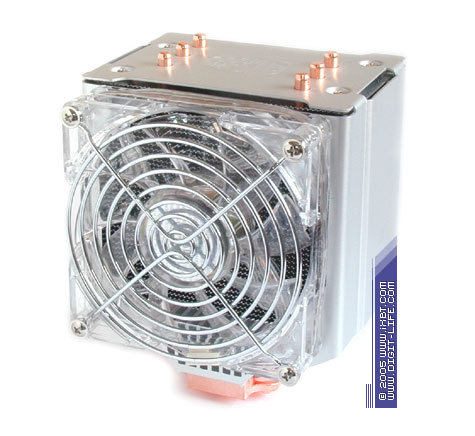 Hyper 6+ heatsink is really impressive — though in some respects it's a simplified modification of its forefather (it uses a combined copper-aluminum heatsink instead of an all-copper one), an additional plus in the title is well deserved by its general technical design. Just dimensions alone count for a lot — 118x82x148 mm! That's raw power even compared to the hypertrophied Hyper 6! 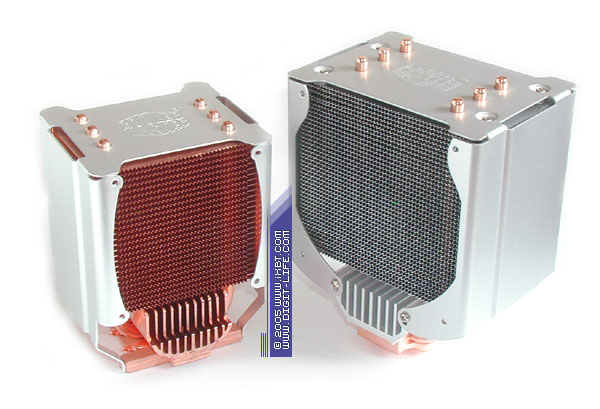 Technical innards are very good as well. They inherit the best family traits of Hyper 6 — the working medium of the overhauled cooler is made up of 6 copper heat pipes (6 mm in diameter) and a section of aluminum heat dissipating plates (0.3 mm thick) at 2 mm steps (43 pieces), supplemented with an aluminum 52x76x25 mm heatsink (at the base of the cooler) and spiced up with several thermal efficiency benefactors - saw-toothed fins and three through holes in finning, which should reduce pressure loss between fins and improve air flow through the heatsink. We should also mention the highly-developed heat dissipation surface area — about 6800 cm2 in total, that is nearly twice as large as in Hyper 6! Assemblage quality of the heatsink also remains traditionally high — all critical joints of heat pipes with the base and finning of Hyper 6+ are honestly soldered to ensure optimized contact thermal resistance. 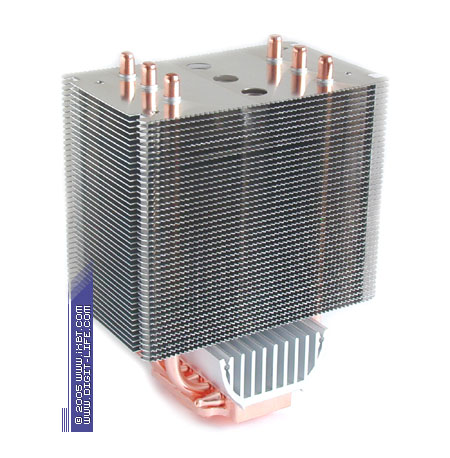 The heatsink is not the only one to look great, this cooler comes shipped with a decent bundle. The Hyper 6+ bundle includes: good-looking 100x100x25 mm fan, equipped with PWM (PWM controller varies the rotational speed from 1800 to 3600 rpm), a protective grille, multiplatform retention module (4 retention brackets plus a universal retention plate), a set of mounting hardware and plastic seals, thermal compound, and the Installation Instructions. 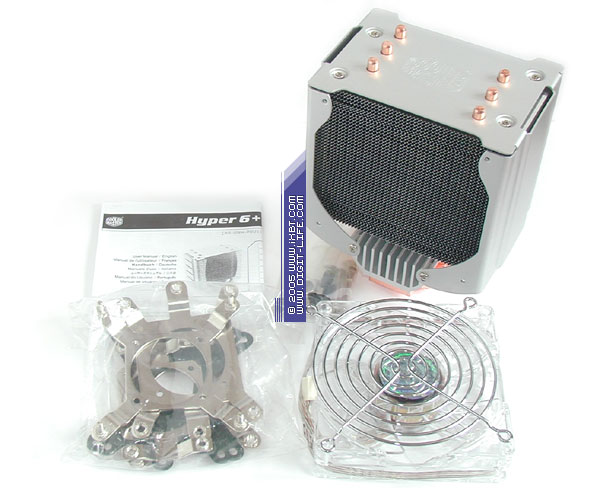 The new Hyper 6+ is much better than its predecessor in terms of service properties — the main contribution here is made by full multiplatform compatibility (it supports all existing platforms — LGA775, Socket 754/939, Socket 478, Socket A) and by the installation process, though a tad labour-consuming, we have no critical gripes with it. An additional advantage of Hyper 6+ over Hyper 6 is its removable heatsink shroud, so that the cooler can be easily used in passive fanless mode (in PC cases with an exhaust-ventilation fan). A special design of the heatsink base also contributes much to the positive side. It ensures correct orientation of the cooler inside a PC case, in harmony with inner air flows and irregardless of the orientation of a motherboard socket. 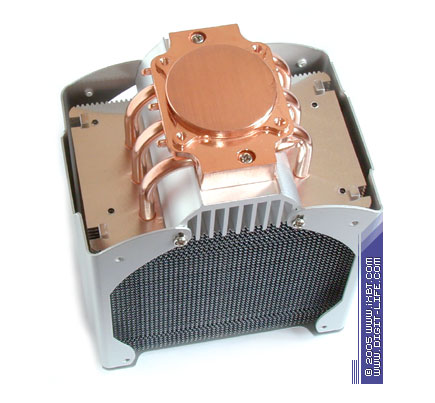 But what concerns thermal efficiency of the updated Hyper 6+, it's approximately on a par with the old Hyper 6 — in our today's Socket 754 tests both coolers demonstrate practically identical results, running at full speed as well as in a slow mode. But Hyper 6 is superior in noise ergonomics and demonstrates a more attractive efficiency/noise ratio. Unfortunately, it was impossible to install Hyper 6 on LGA775, so we couldn't compare it with Hyper 6+ directly. Nevertheless, it's safe to say that the layout of forces here would be the same as on the Socket 754/939 platform. Cooler Master Hyper 48Another representative of the noble Hyper family from Cooler Master, Hyper 48, looks more unassuming. It's based on a 94x105x65 mm copper heatsink with a 92x92x25 mm fan and an integrated fan speed controller (PWM controller varies the rotational speed from 1400 to 3200 rpm). 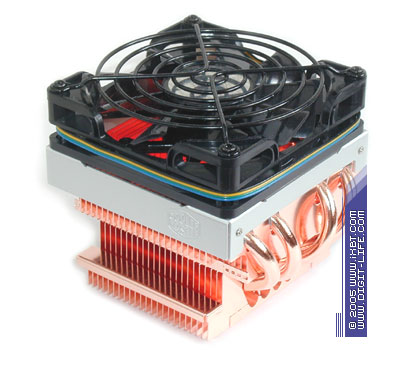 Like Hyper 6+, the Hyper 48 heatsink is equipped with copper heat pipes (4 pieces, 6 mm in diameter). It also has a section of fins (23 main fins plus 8 peripheral ones, 0.3 mm thick, at 3 mm steps). But now these fins are made of copper and they are arranged vertically instead of horizontally; in some places their edges touch the base. In other words, it's a traditional heatsink with bonded fins. Along with channeling the heat from the base, its heat pipes act as additional thermal catalysts — they warm up the upper peripheral part of the heatsink to increase finning efficiency. Hyper 48 offers quite decent technical parameters (the total heat exchange surface area is about 2500 cm2), but its image suffers from one annoying nuance — heat pipes are glued to the base and finning, which does not contribute to the thermal contact quality and does not allow maximum optimization of the thermal resistance of the heatsink. 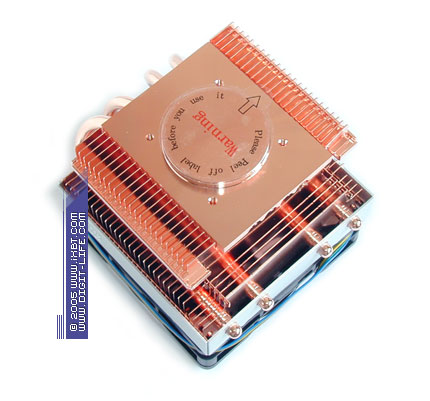 What concerns its properties, Hyper 48 takes after Hyper 6 in many respects — the cooler is equipped with practically the same whimsical and not quite convenient retention module, adapted for Socket 754/939 and Socket 478 (it's a specialized mounting frame with a retention plate and hard clips), with all the ensuing consequences. Cooler's weight gives rise to some unfavorable criticism. It's about 900 g in Hyper 48 and seems excessive for this design, especially compared to the weight of larger and more powerful Hyper 6 (950 g) and Hyper 6+ (850 g). The only case when Hyper 48 is indeed good in installation is the LGA775 platform — this retention module is quite user-friendly (it's a combination of a retention plate and a special bracket with standard screws) and provides effortless installation of the cooler into a socket. 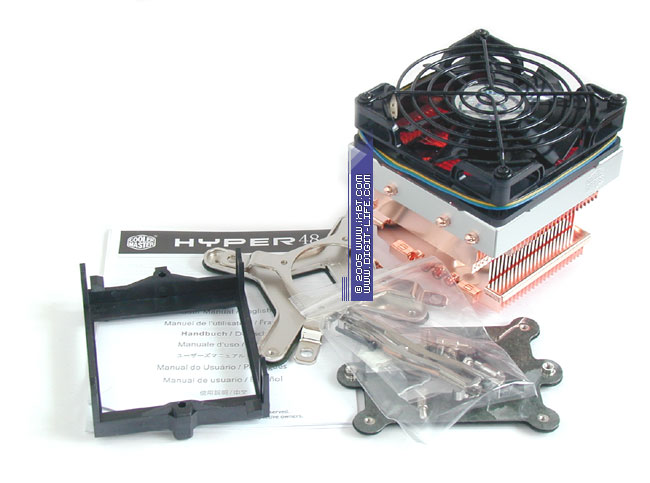 What concerns pure practice, the Hyper 48 is far from its proper efficiency despite its highly developed heatsink: the cooler is not very efficient both on the LGA775 platform as well as on the Socket 754 platform — it's noticeably outperformed by Hyper 6 and Hyper 6+. As a result, its overall functionality is on a par with Zalman CNPS7700-Cu (which is more conservative technically), it's even slightly outperformed by the latter in noise ergonomics, having a worse efficiency/noise ratio. GlacialTech Igloo 5700 MCThe next contender in our list is a new model from GlacialTech — Hi-End Igloo 5700 MC with advanced technical features. 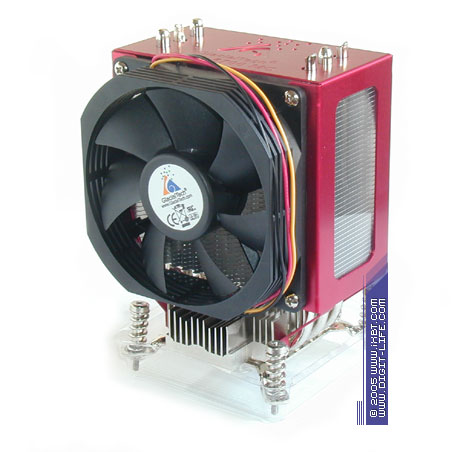 Being adapted for LGA775, Igloo 5700 MC is based on the ideology of successful Igloo 5600 — it possesses a similar design of the working medium, but it has larger dimensions and significantly reinforced thermal components: there are 3 heat pipes (6 mm in diameter) and a section of aluminum fans of an impressive size (100x50 mm, 45 pieces, the heat exchange surface area is about 4400 cm2). The other technical benefactors remain in their places — a copper 33x33x6 mm heatsink (finished in nickel) and an additional aluminum 56x80x25 mm heatsink of a different configuration at the base, which should unload heavily heated areas of heat pipes that contact the heatsink. 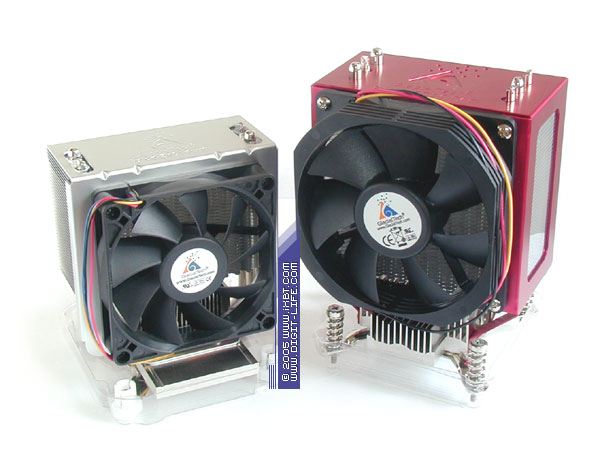 Like in old Igloo 5600, the heatsink of Igloo 5700 MC shows signs of advanced optimization: loosely arranged fins (at 2 mm steps), rather short interfin channels (50 mm), special wave-like profile of fin edges — these measures contribute to the reduction of pressure loss of the heatsink (better air flow), allow to use almost entire heat exchange surface area and thus to increase heat exchange intensity. A new on-board 92x92x25 mm fan with a grilled pipe is of much help here (the nominal rotational speed is 3200 rpm), it offers optimized output characteristics and generates active air flow through the fins. Another technical moment to encourage — heat pipes are soldered to the heatsink and its finning, which improves the quality of their thermal contact and provides minimal thermal resistance. 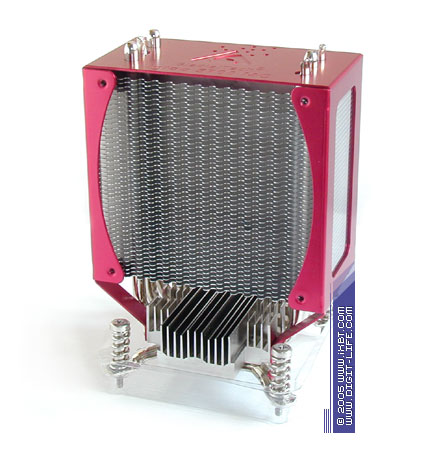
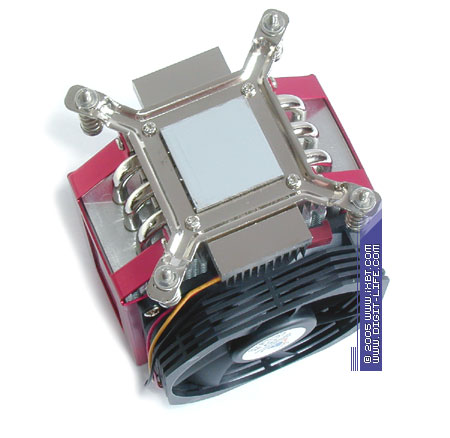 Igloo 5700 MC also offers quite good usability. Though there are no signs of multiplatform compatibility (the cooler is designed solely for LGA775), it's an advantage rather than a drawback — the mounting system is quite simple (the heatsink is screwed to the bundled retention plate through mounting holes on a motherboard) and offers humane installation process, which is facilitated by preinstalled efficient thermal compound. The bundle of Igloo 5700 MC also includes a potentiometer, mounted on a nice 3.5" faceplate (rotational speed of the fan varies from 1400 to 3000 rpm). 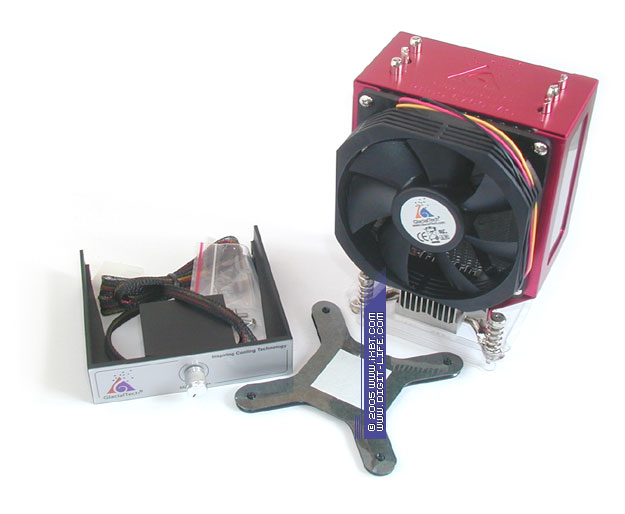 Hence, Igloo 5700 MC demonstrates robust thermal efficiency. The most remarkable results are achieved at full speed (3000 rpm) — in this case the cooler outperforms many decent competitors and comes close to the leaders of this shootout — Scythe Ninja and Zalman CNPS9500 LED. And it does it without much fuss and noise. Igloo 5700 MC also fairs well in quiet mode (1400 rpm) — the cooler keeps its thermal efficiency on a respectable level, while its noise characteristics become truly ergonomic and humane. GlacialTech Igloo 7700 MCAnother top model from GlacialTech, Igloo 7700 MC, inherits practically the same family traits as in the Igloo 5700 MC, adapted for Socket 754/939. 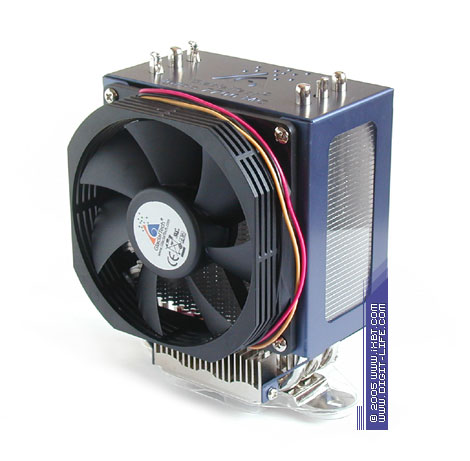 Indeed, Igloo 7700 MC equals Igloo 5700 MC in technical terms — it has an identical heatsink (the same combination of three copper heat pipes and a section of 45 aluminum plates (100x50 mm)) and an on-board 92x92x25 mm fan with a copper nickel-plated 33x33x6 mm heatsink, and an additional aluminum heatsink of the same configuration with smaller dimensions - 56x52x25 mm. 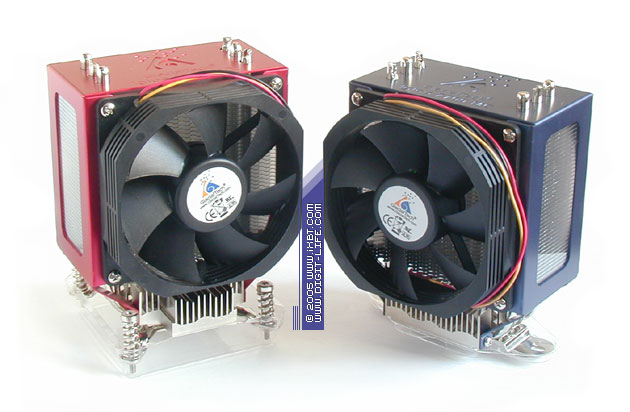 The only considerable difference of the Igloo 7700 MC expectedly lies in its base — instead of the LGA775 retention bracket, we can see a special retention plate of an original design, which provides tight and strictly normative installation of the heatsink into Socket 754/939. The cooler also weighs differently (510 g, approximately 60 g as light as Igloo 5700 MC). 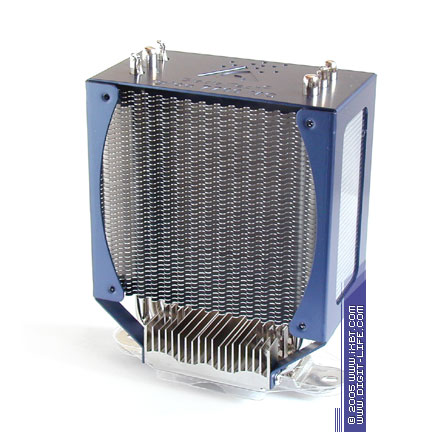
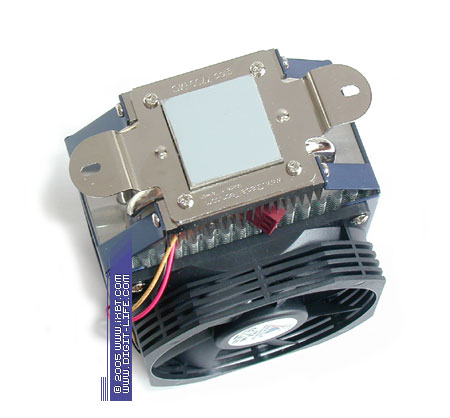 Narrow specialism of Igloo 7700 MC for the AMD platform becomes an advantage again — well thought-out retention mechanism makes it quite easy to install this cooler (in most cases the cooler is screwed directly to the mounting frame of the socket with two bundled screws). Preinstalled thermal compound and an Igloo5700MC-like potentiometer (fan rpm varies from 1400 to 3000) are of additional help to Igloo 7700 MC. 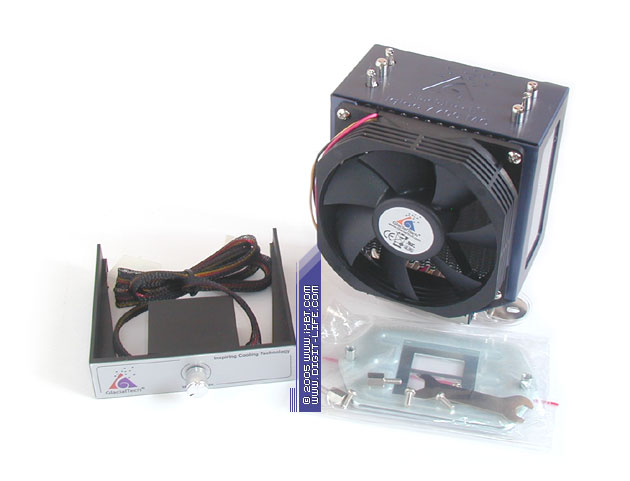 The new Igloo 7700 MC maintains its reputation in terms of thermal efficiency as well. Running at full speed (3000 rpm), the cooler follows many footsteps of Intel's counterpart of Igloo 5700 MC — it's practically on a par with Cooler Master models — Hyper 6 and Hyper 6+, it comes close to the champion results of Scythe Ninja. But in noise terms, it tries to keep in ergonomic limits. This model also fairs well at minimum speed (1400 rpm) — it successfully competes with many opponents with low-speed fans, demonstrating truly low-noise operation along with a remarkable efficiency/noise ratio. Scythe ShogunNow it's time for a new Hi-End model from Japanese Scythe (it's a well known and recognized manufacturer on the world arena, but it's little known to our Russian customers) — a cooler with a high-sounding name Shogun. 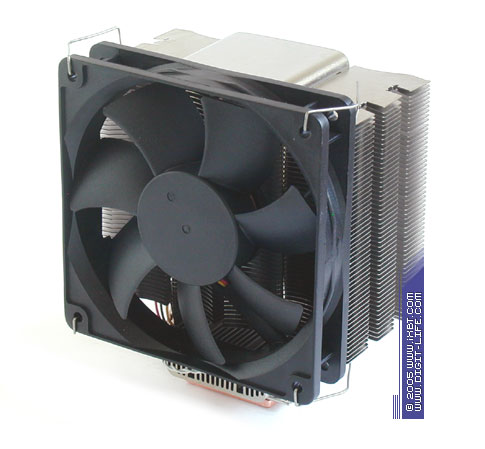 Scythe Shogun is an unusual product in many respects, if not unique. A general feature of this cooler is a heatsink, built on the progressive Heatlane technology from Japanese TS Heatronics: instead of a standard set of heat pipes, it uses a so-called self-excited oscillation heat pipe, invented by Japanese engineer Hisateru Akachi, which possesses a number of significant advantages over typical heat pipes. Detailed physics of the process inside such a self-excited oscillation heat pipe is rather complex (our most curious readers can find theoretical and practical articles on this topic in Internet, there are a couple dozens of them). But on the whole, the engineering essence of the Heatlane technology is quite comprehensible — such a heat pipe is actually a simple arrangement of flat micro pipes (1x1 mm in cross-section) - 10 or more pipes (in fact, it's a single long Z-fold micropipe, which is partially filled with coolant and hermetically packed into a single flat plate). You can see it in action on the illustrative roentgenogram on the TS Heatronics web site. 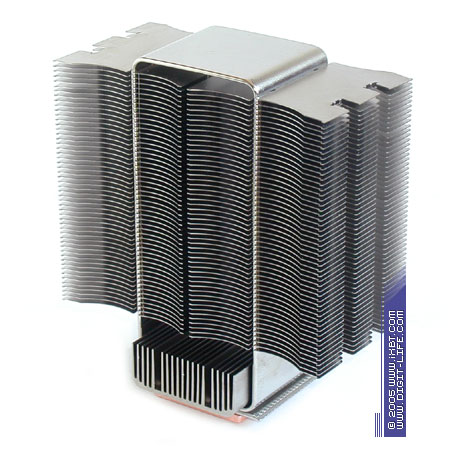 So, the frame of Shogun (a looped aluminum plate - 50 mm wide and 2 mm thick) is the high-tech self-excited oscillation heat pipe Heatlane (40 1x1 mm micro channels). Shogun has a no less interesting design in other respects: 122x70x144 mm, two sections of heat dissipating plates (60x55 mm) arranged at 2 mm steps (52 pieces in each section), an additional aluminum 49x70x18 mm heatsink joined to the Heatlane pipe, as well as a copper 42x50x4 mm heatsink soldered to the base of the main heatsink look very promising. The total heat exchange surface area is increased to 7800 cm2 - it's a record among our today's contenders. 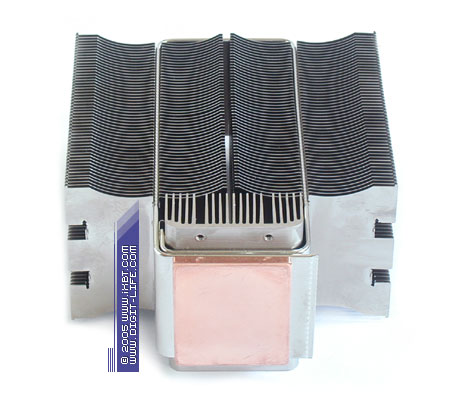 Shogun also has a good bundle. The bundle includes: 120x120x25 mm fan with a potentiometer (rotational speed varies from 800 to 1600 rpm), a power converter, a multiplatform retention module (it supports three platforms — LGA775, Socket 754/939, and Socket 478), mounting metalware, a satchel with thermal compound, and a detailed manual. 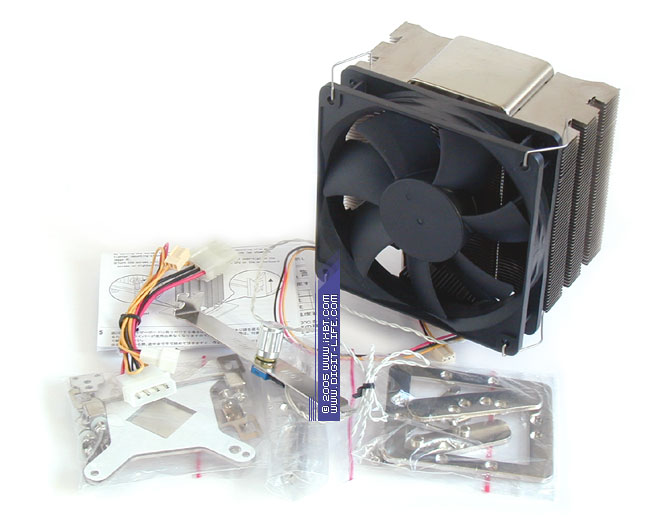 At the same time, this cooler is rather capricious in usage "thanks" to its multiplatform retention module, which is a disadvantage rather than an advantage. It makes the installation process very hard. You will have plenty of trouble in case of Socket 754/939 as well as LGA775. In the latter case, a user must be especially careful — to install the heatsink into the socket really tight and not misaligned, you will have to manipulate the retention module with great care and precision. Fortunately, having put much effort into the installation process, you will not be disappointed by its efficiency — Shogun uses its high-tech innards to advantage and puts up a great performance. Operating in quiet mode (800 rpm), the cooler does not manage to achieve champion results. But the noise level keeps strictly within friendly ergonomics. Shogun demonstrates a respectable efficiency/noise ratio. The standard mode (1600 rpm) puts everything in its place: thermal efficiency grows significantly — the cooler outperforms many strong contenders and successfully competes with Thermaltake BigTyphoon and Zalman CNPS9500 LED (Silent Mode), while its noise still remain ergonomic and barely audible. But the full thermal potential of this model is revealed after installing two 1600 rpm fans — this modification of Shogun catches up with today's leaders — Scythe Ninja and Zalman CNPS9500 LED (Normal Mode), staying rather quiet. Scythe NinjaAnother model from Scythe, Ninja, is designed in accord with the classic canons of heat pipe technologies and does not offer any unique technical solutions. But this is also a powerful model with great thermal efficiency. 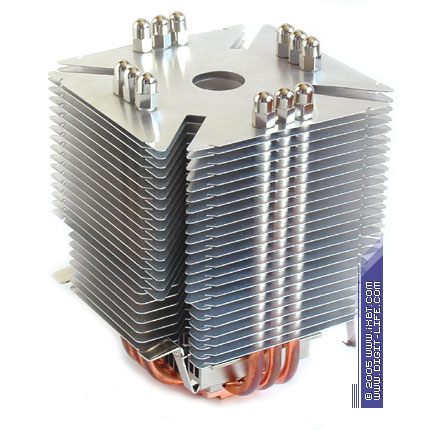 With all its traditional ideology, Ninja's heatsink can certainly outscore huge Shogun in technical terms: developed external finning — a section of 23 aluminum plates (0.4 mm thick, 110x110 mm) and six copper heat pipes (6 mm in diameter), woofed into 12 heat release elements, will not leave unaffected even a hardcore skeptic. The other remarkable thermal benefactors are an additional aluminum 65x54x25 mm heatsink at the base of the cooler (it should unload the most heavily heated areas of the heat pipes and the base) and a copper 52x38x6 mm heatsink at the base. 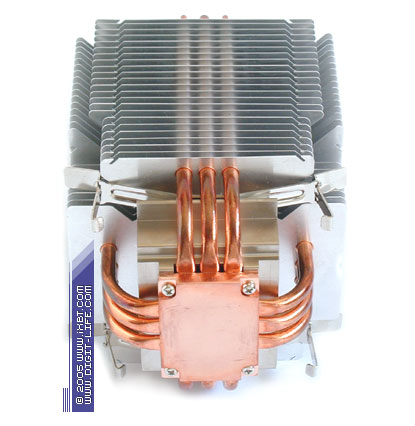 Ninja features well thought-out finning — the fins are arranged at very large steps (4 mm) and have a very intricate form with four diagonal and one central notch to minimize pressure loss and provide excellent air flow through the heatsink with nearly ideal heat transfer ratios. The total heat exchange surface area also reaches quite respectable values, about 4500 cm2. Mind it, practically the entire surface works efficiently thanks to the increased number of contacts with heat pipes together with the optimized fin configuration - both in the bottom (heavily loaded) and top peripheral parts of finning. And of course we should mention good contact quality between the heat pipes, the base, and Ninja finning - they are soldered. While in technical terms Ninja is worthy of great praise, its bundle is rather scanty and even slightly disappointing: there are no heatsink fans, just a multiplatform retention module (adapted for LGA775, Socket 754/939, and Socket 478), thermal compound, and a manual. 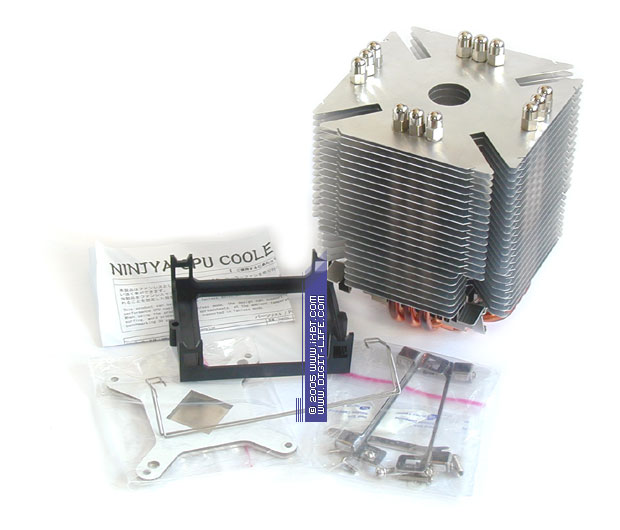 Nevertheless, Ninja's usability turns out much more attractive and friendly than in Shogun. The retention module is quite simple here and provides humane installation process — in case of Socket 754/939, you should just replace the retention bracket and fix the heatsink with clips; in case of LGA775, you will also have to install special brackets into mounting holes of a motherboard (these operations will pose no problems either). 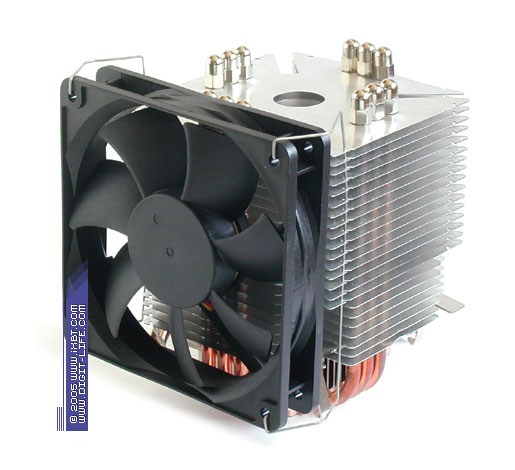 What concerns the resulting efficiency of this model, it's just excellent! Spiced up with a 120x120x25 mm fan (from Shogun's bundle), Ninja easily outperforms many worthy competitors and shares the palm with Zalman CNPS9500 LED. Installed with two fans, this model breaks a new record in thermal efficiency on the LGA775 platform and becomes an absolute champion among air coolers, having come close to advanced water cooling systems.
Part 2. Devices from Thermaltake, Titan and ZalmanPart 3. Test results, Conclusions
Write a comment below. No registration needed!
|
Platform · Video · Multimedia · Mobile · Other || About us & Privacy policy · Twitter · Facebook Copyright © Byrds Research & Publishing, Ltd., 1997–2011. All rights reserved. |